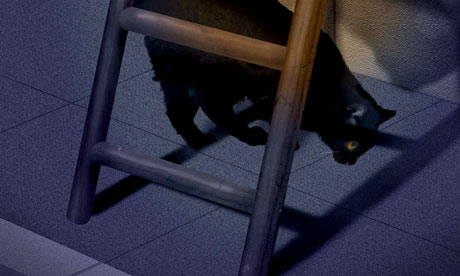As we have just suffered a general election in Australia, I thought this would be a good time to record a visit I made to Old Parliament House back in May. Although I intensely dislike the new Prime Minister and his party, the whole concept of democracy is an honourable one, and the place in which it is (or was) conducted is a venerable building.
A tour had just got underway when I arrived at Old Parliament House, so I joined it. We began in the Senate, which is decorated in red, similar to the House of Lords, and has panels on the windows to reduce glare and enhance acoustics. There is a special seat reserved for the monarch and consort or the Governor General and spouse.
Dividing the Senate from the House of Representative, the King’s Hall (named after King George V who was king at the time it was built) is bright and simplistic – a classic design. There are bas reliefs in the columns and portraits hung on the walls which are owned by the National Portrait Gallery for Old Parliament House.
The House of Representatives is decked out in Eucalyptus Green (an Australian take of the House of Commons). Old Parliament House – or Provisional Parliament House (PPH) as it was called – was in use from 1927 to 1988. The benches are all made of alternating panels of Australian black bean wood and Tasmanian Blackwood.
The Speaker’s Chair was a gift from Britain and is a copy of A.W.N. Pugin’s Speaker’s Chair in the House of Commons. The Royal coat of arms over the chair is carved in oak from timber originally built into Westminster Hall in 1399. The hinged flaps of the armrests are of oak from Nelson’s flagship HMS Victory. It was built using traditional medieval methods (no screws or nails etc).
As one of only two international gifts of furniture to be presented to Provisional Parliament House, the furniture has great symbolism, alluding to the Australian Parliament’s associations with British history and the Parliament at Westminster. Sir Littleton Groom, the first speaker in the PPH, stated the chair stood for ‘the authority, honour and dignity of Parliament… it will inspire feelings of affection, esteem and gratitude towards the land that gave birth to Parliamentary institutions.’
This relationship was reinforced when the Speaker’s Chair in the British House of Commons was destroyed during an air raid in 1941. The Australian Government presented the British House of Commons with a replica Speaker’s Chair carved by British craftsmen out of Australian black bean wood with ‘The Gift of Australia’ carved across the back. It tickles me to think that each Parliament has a foreign Speaker’s Chair.
The mace is another gift to the Australian Parliament by Great Britain. Made in London, it was designed to resemble the Mace used in the British House of Commons but is etched with designs of fruit, rams’ heads and wheat to symbolise the importance of Australia’s sheep and agricultural industries. The gift in 1951 marked the silver jubilee of Australia’s federation. The real mace is obviously in the ‘new’ Parliament House (referred to throughout the tour as ‘the house on the hill’); this is merely a replica.
The tour led us through the warren-like maze of corridors to the Prime Minister’s suite of offices. They were commissioned by William McMahon but he never got to use them as he lost the 1972 election to Gough Whitlam. Each Prime Minister to work from the office chose artworks for display, located his desk in a different position, and chose new curtains.
In its current configuration, it is presented as it was during Bob Hawke’s term of office, as the last Prime Minister to work in PPH. The Arthur Boyd painting on the wall is a replica of his choice, which has been the subject of much symbolic speculation. The Prime Minister’s Secretary had a peephole into the PM’s office, which probably also raised plenty of discussion!
We were also guided to the Government Party Room, where every newspaper in Australia was delivered. It was the only way many could find out what was happening in their constituencies. The sound-proof telephone booths were apparently often used for private conversations with two or three members squeezing in there.
Members must never miss divisions and there are clocks here as there are in every room so members could always see one – there are over 900 in the building. When the bells rang, the members had three minutes to reach the chamber and they would race along the corridors – staffers knew to stand back against the walls to avoid being flattened.
Our tour finished, we were free to wander the building and look at whatever we chose. It seems that for all its foibles, it was quite a popular building and one member even felt moved to write a poem for it.
Farewell Old Parliament by Ralph Hunt, member for Gwydir 1969-1989
Farewell to you Old Provisional
As we your spirits depart
Leaving our house so traditional
Another era is about to start
We leave you as an empty shell
A host of memories to protect
No longer will you ring your bell
Calling politicians to reflect.



.jpg)
.jpg)
.jpg)
.jpg)
.jpg)
.jpg)
.jpg)
.jpg)
.jpg)
.jpg)
.jpg)
.jpg)
.jpg)
.jpg)
.jpg)
.jpg)
.jpg)
.jpg)
.jpg)
.jpg)
.jpg)
.jpg)
.jpg)
.jpg)
.jpg)
.jpg)
.jpg)
.jpg)
.jpg)
.jpg)
.jpg)
.jpg)
.jpg)
.jpg)

.jpg)
.jpg)
.jpg)
.jpg)
.jpg)
.jpg)
.jpg)
.jpg)